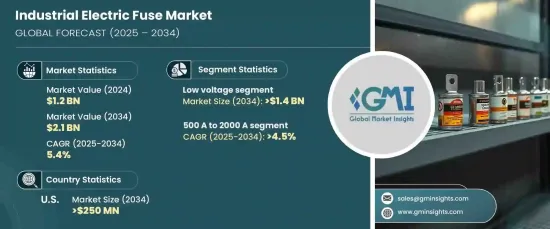 |
市場調查報告書
商品編碼
1667093
工業電保險絲市場機會、成長動力、產業趨勢分析與 2025 - 2034 年預測Industrial Electric Fuse Market Opportunity, Growth Drivers, Industry Trend Analysis, and Forecast 2025 - 2034 |
||||||
全球工業電保險絲市場將實現顯著成長,其估值將在 2024 年達到 12 億美元,預計在 2025 年至 2034 年期間將以 5.4% 的強勁複合年成長率成長。政府加強輸配電網路的舉措,加上汽車產業的蓬勃發展和更嚴格的保險絲安裝安全規範,是推動該市場向前發展的關鍵因素。

隨著工業不斷擴張,對電氣安全設備的需求不斷增加,預計到 2034 年低壓市場將創收 14 億美元。嚴格的安全法規鼓勵業界採用可靠的低壓系統保險絲解決方案,確保防止過載和短路。此外,電動車的快速普及和工業基礎設施發展的投資也增強了對先進電氣元件的需求,從而推動了該領域的成長。
| 市場範圍 | |
|---|---|
| 起始年份 | 2024 |
| 預測年份 | 2025-2034 |
| 起始值 | 12億美元 |
| 預測值 | 21億美元 |
| 複合年成長率 | 5.4% |
額定電流在 500 A 至 2000 A 之間的保險絲將實現大幅成長,預計 2024 年至 2034 年的複合年成長率為 4.5%。 製造業和能源等行業對自動化和重型機械的依賴日益增加,加劇了對大容量保險絲的需求。先進的安全要求和保護關鍵基礎設施的必要性正在推動創新,製造商推出耐用而高效的解決方案,以滿足對安全電氣保護系統日益成長的需求。
由於快速的工業成長、廣泛的數位轉型以及對電力基礎設施現代化的大量投資,美國工業電保險絲市場預計到 2034 年將達到 2.5 億美元。升級輸電網路、滿足不斷成長的電力需求以及現代化電網基礎設施的努力正在創造有利可圖的機會。這些措施與政府提高半導體製造能力和加強國家能源基礎設施的策略密切相關。
目錄
第 1 章:方法論與範圍
- 市場定義
- 基礎估算與計算
- 預測計算
- 資料來源
- 基本的
- 次要
- 有薪資的
- 民眾
第 2 章:執行摘要
第 3 章:產業洞察
- 產業生態系統分析
- 監管格局
- 產業衝擊力
- 成長動力
- 產業陷阱與挑戰
- 成長潛力分析
- 波特的分析
- 供應商的議價能力
- 買家的議價能力
- 新進入者的威脅
- 替代品的威脅
- PESTEL 分析
第4章:競爭格局
- 介紹
- 戰略儀表板
- 創新與永續發展格局
第 5 章:市場規模與預測:按電壓,2021 – 2034 年
- 主要趨勢
- 低的
- 高的
第 6 章:市場規模與預測:按當前評級,2021 年至 2034 年
- 主要趨勢
- 500A-2000A
- 2000-4000A
- >4000安
第 7 章:市場規模及預測:按地區,2021 – 2034 年
- 主要趨勢
- 北美洲
- 美國
- 加拿大
- 墨西哥
- 歐洲
- 英國
- 挪威
- 德國
- 義大利
- 荷蘭
- 亞太地區
- 中國
- 日本
- 印度
- 韓國
- 中東和非洲
- 沙烏地阿拉伯
- 阿拉伯聯合大公國
- 土耳其
- 拉丁美洲
- 巴西
- 阿根廷
第8章:公司簡介
- ABB
- Bel Fuse
- Carling Technologies
- C&S Electric
- Denco Fuses
- DF Electric
- Eaton
- Fuji Electric
- Hager Group
- Legrand
- Littelfuse
- Mersen
- Optifuse
- S&C Electric Company
- Schneider Electric
- SCHURTER Global
- Siba
- Socomec
- SOC Corporation
The Global Industrial Electric Fuse Market is set to achieve remarkable growth, with its valuation hitting USD 1.2 billion in 2024 and projected to expand at a robust CAGR of 5.4% from 2025 to 2034. This surge is fueled by rapid industrialization and the widespread adoption of digital technologies across key sectors such as manufacturing, automotive, and energy. Government initiatives to enhance power transmission and distribution networks, coupled with the dynamic growth of the automotive industry and stricter safety norms for fuse installations, are key factors propelling this market forward.

The low voltage segment is expected to generate USD 1.4 billion by 2034, driven by the escalating demand for electrical safety devices amid ongoing industrial expansion. Stringent safety regulations are encouraging industries to adopt reliable fuse solutions for low voltage systems, ensuring protection against overloads and short circuits. Additionally, the rapid adoption of electric vehicles and investments in industrial infrastructure development are bolstering the need for advanced electrical components, fueling growth in this segment.
| Market Scope | |
|---|---|
| Start Year | 2024 |
| Forecast Year | 2025-2034 |
| Start Value | $1.2 billion |
| Forecast Value | $2.1 Billion |
| CAGR | 5.4% |
Fuses with current ratings between 500 A and 2000 A are poised for significant growth, with a CAGR of 4.5% forecasted from 2024 to 2034. The increasing reliance on automation and heavy machinery in industries such as manufacturing and energy has intensified the demand for high-capacity fuses. Advanced safety requirements and the imperative to protect critical infrastructure are driving innovation, with manufacturers introducing durable and efficient solutions to meet the rising demand for secure electrical protection systems.
The U.S. industrial electric fuse market is projected to reach USD 250 million by 2034, bolstered by rapid industrial growth, widespread digital transformation, and significant investments in power infrastructure modernization. Efforts to upgrade transmission networks, address growing power demands, and modernize grid infrastructure are creating lucrative opportunities. These initiatives are closely aligned with government strategies to enhance semiconductor manufacturing capabilities and strengthen the nation's energy infrastructure.
Table of Contents
Chapter 1 Methodology & Scope
- 1.1 Market definitions
- 1.2 Base estimates & calculations
- 1.3 Forecast calculation
- 1.4 Data sources
- 1.4.1 Primary
- 1.4.2 Secondary
- 1.4.2.1 Paid
- 1.4.2.2 Public
Chapter 2 Executive Summary
- 2.1 Industry synopsis, 2021 - 2034
Chapter 3 Industry Insights
- 3.1 Industry ecosystem analysis
- 3.2 Regulatory landscape
- 3.3 Industry impact forces
- 3.3.1 Growth drivers
- 3.3.2 Industry pitfalls & challenges
- 3.4 Growth potential analysis
- 3.5 Porter's analysis
- 3.5.1 Bargaining power of suppliers
- 3.5.2 Bargaining power of buyers
- 3.5.3 Threat of new entrants
- 3.5.4 Threat of substitutes
- 3.6 PESTEL analysis
Chapter 4 Competitive Landscape, 2024
- 4.1 Introduction
- 4.2 Strategic dashboard
- 4.3 Innovation & sustainability landscape
Chapter 5 Market Size and Forecast, By Voltage, 2021 – 2034 (USD Million, ‘000 Units)
- 5.1 Key trends
- 5.2 Low
- 5.3 High
Chapter 6 Market Size and Forecast, By Current Rating, 2021 – 2034 (USD Million, ‘000 Units)
- 6.1 Key trends
- 6.2 500A-2000A
- 6.3 2000-4000A
- 6.4 > 4000A
Chapter 7 Market Size and Forecast, By Region, 2021 – 2034 (USD Million, ‘000 Units)
- 7.1 Key trends
- 7.2 North America
- 7.2.1 U.S
- 7.2.2 Canada
- 7.2.3 Mexico
- 7.3 Europe
- 7.3.1 UK
- 7.3.2 Norway
- 7.3.3 Germany
- 7.3.4 Italy
- 7.3.5 Netherlands
- 7.4 Asia Pacific
- 7.4.1 China
- 7.4.2 Japan
- 7.4.3 India
- 7.4.4 South Korea
- 7.5 Middle East & Africa
- 7.5.1 Saudi Arabia
- 7.5.2 UAE
- 7.5.3 Turkey
- 7.6 Latin America
- 7.6.1 Brazil
- 7.6.2 Argentina
Chapter 8 Company Profiles
- 8.1 ABB
- 8.2 Bel Fuse
- 8.3 Carling Technologies
- 8.4 C&S Electric
- 8.5 Denco Fuses
- 8.6 DF Electric
- 8.7 Eaton
- 8.8 Fuji Electric
- 8.9 Hager Group
- 8.10 Legrand
- 8.11 Littelfuse
- 8.12 Mersen
- 8.13 Optifuse
- 8.14 S&C Electric Company
- 8.15 Schneider Electric
- 8.16 SCHURTER Global
- 8.17 Siba
- 8.18 Socomec
- 8.19 SOC Corporation









